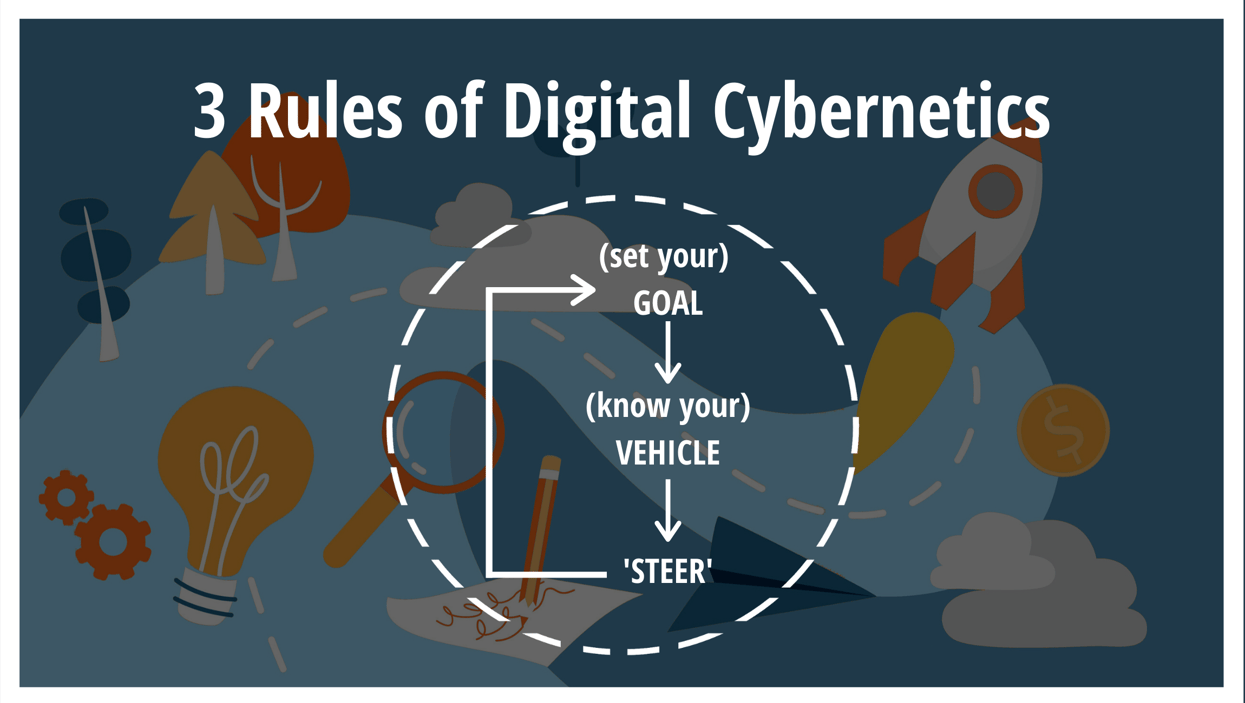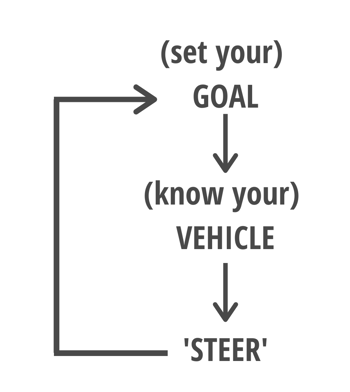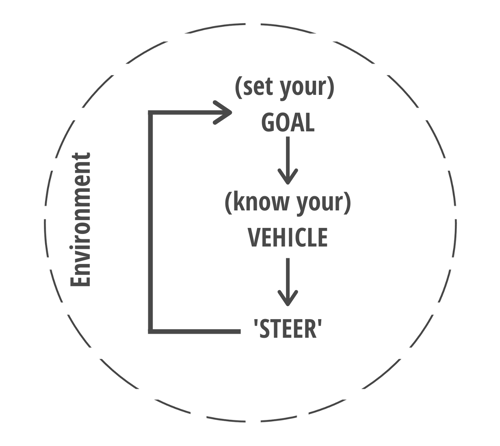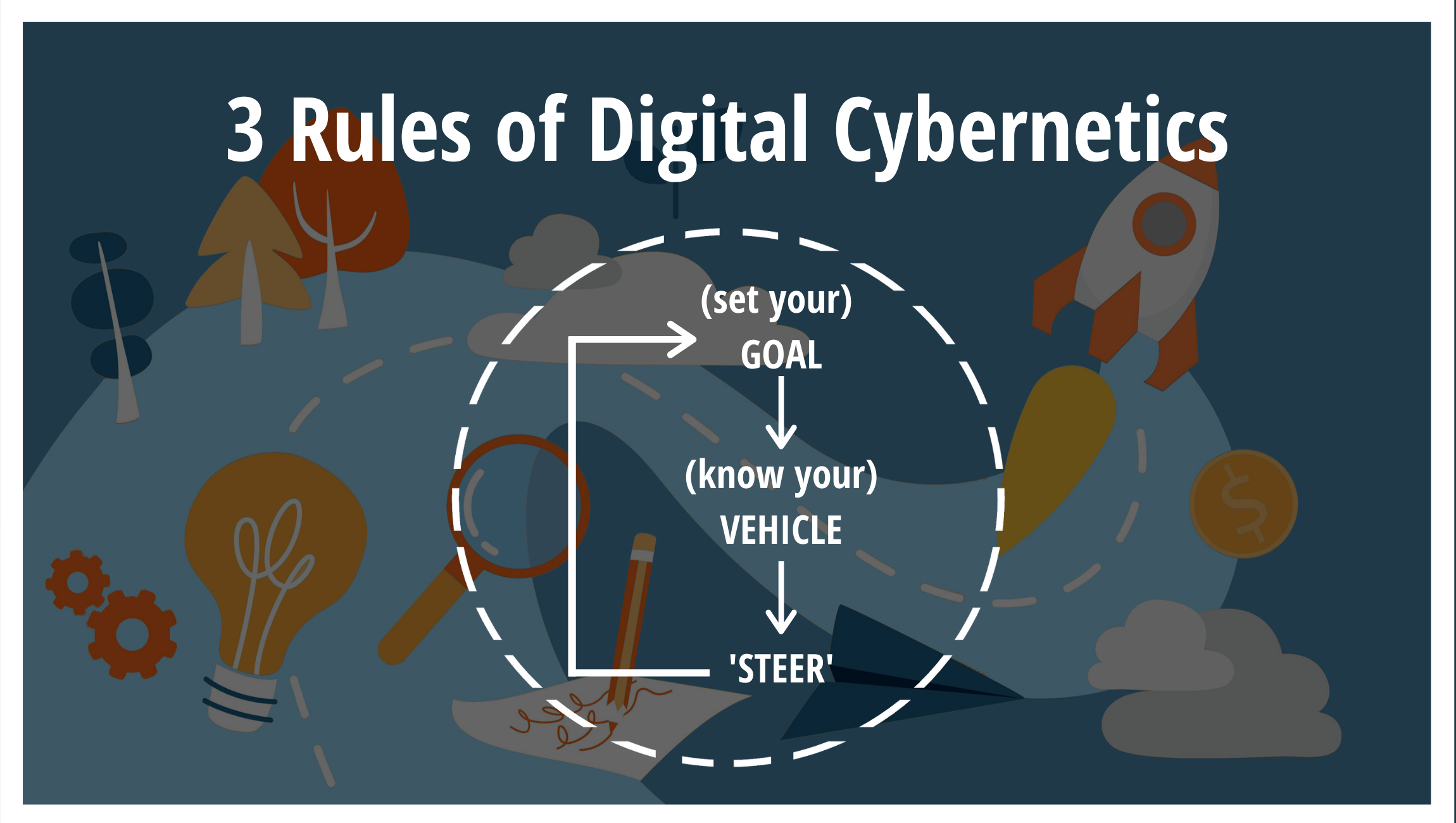
If you asked me to sum up Digital Cybernetics in the smallest number of words possible, I’d say the following:
Set your GOAL,
Know your VEHICLE, then
‘STEER’
And if you wanted me to turn that into an image, I’d simply show you this:

And if you wanted it in a sentence I would probably reverse it to:
STEER your VEHICLE toward your GOAL
There we go. Job done. You’ve now got the 3 rules of Digital Cybernetics.
But actually there is a lot of meaning embedded within this sentence, or should I say, within the ‘circular process’ it represents.
As such, this chapter will give you an active metaphor to help you understand the framework better, as well as how to implement it ‘at the helm’ - starting with the ‘Steering’.
STEERING
In Pangaro’s summary of Cybernetics (source), he says...
Cybernetics named From Greek ‘kubernetes’ — same root as ‘steering’ — becomes ‘governor’ in Latin
And continues...
Cybernetic point-of-view:
- system has goal
- system acts, aims toward the goal
- environment affects aim
- information returns to system — ‘feedback’
- system measures difference between state and goal — detects ‘error’
- system corrects action to aim toward goal
- repeat
In his presentation, he supports these principles with the following process, reproduced in the slides below where he runs through how steering leads to ‘course correction’:
Here we see the process in action, where the vehicle is being steered toward the goal in a series of adjustment. There is something very satisfying about how small the adjustments are - yet enable the boat ‘back on course’.
Next...
You need a VEHICLE
Returning to ‘STEER your VEHICLE toward your GOAL’, you can see that word ‘vehicle’.
Your vehicle is most often a business or organisation, and you need a vehicle that is capable of being steered toward your goals.
Its nature will determine its ability to EVER reach the goal.
Sometimes you’ll need to pedal and steer a small vehicle toward a ‘lesser goal’, and then change vehicle to attain a greater goal. In other words, your vehicle can be transformed through the accomplishment of milestones.
Your vehicle can also ‘have a leak in it’, through disconnected systems within the fabric of it’s own body - which in turn will affect how you can steer it. Putting it simply, if your vehicle is sinking, you may find steering a challenge. But it’s not just about that, your vehicle is the system in which you operate that you’re capable of influencing directly. Without the ability to influence ‘where the vehicle is pointed’, this may not really be your vehicle.
Next, let’s have a look at ‘Goal’ as our final aspect...
GOAL
Your 'goal' is your desired destination.
You may well have your goal firmly in mind i.e. you know where you are trying to get to, but that does not mean you are going to get there.
Assuming your vehicle has the capability, you may still fail to reach your goal.
One thing that can happen is when you cannot see clearly - then you are unable to accurately steer a course toward your goal. From a Digital Cybernetics perspective, and one that we’re consistently finding during client work, the issue is prevalent when you cannot see the direct consequence to actions taken. This may well be through systems not being connected, or a situation where the person acting is unable to access the information that would be useful to inform whether their actions are ‘working’. Think about a marketer who can’t ‘hear’ how salespeople deal with leads being generated - they simply don’t get to understand and appreciate this part of the ‘prospect to customer’ journey.
Your inability to ‘see’ that doing X creates Y, you are steering without getting the feedback to the results being achieved. This lack of feedback creates doubt and uncertainty to the causation of action to any results being shown.
Knowing this, however, you can prioritise the ability to see clearly before you focus on the nuances of steering, or optimising the process of moving toward your Goal.
When the issues you face are ‘internal’, they may be either an ‘Organisation’ issue or an issue of communication (systems and people) between the parts of your vehicle. Just about all of these are resolvable.
And when the problem is internal, we could say we need to remove the ‘MIST’ - which will fade when we ‘Make Invisible Systems Transparent’.
This idea of moving from invisible to transparent is quite subtle, but one that will help you ‘see’ what is happening, where previously you couldn’t - and instead you simply had the (probably) incomplete map inside your head as to how the system operated. With transparency, you can see better which bits connect, and how information flows.
As I say the MIST dissipates when you make invisible systems transparent - seeing all the ‘workings’.
Note: one of the best ways to do this is through Business Process Mapping.
Next we need to consider how there is also an Environmental context in which an organisation operates...
The role of environment
In the example of the boat and steering, the environment is explained by the wind/tide, and operates as a force acting on the boat.
Taking this onboard, we can add in the new element of ‘Environment’ to our original sketch:

From a Digital Cybernetic perspective, your environment is the social system context within with you operate - the laws, the taxation, office layout, etc.
There is also the ‘digital environment’ of your own business i.e. the systems you employ, the people operating them, and the level of connectedness across the organisation - The same goes for your competition as well. And all of this operates within that broader systems/environmental context.
Let’s take a look at this with a few scenarios relating to taking a new product to market, which should help explain how this differs:
- If you have a new product that you want to take to market and NO-ONE is looking for that product, then you don’t have a given that you’ll have people who want your product pay attention. Instead, you may well need to educate the market in a broader manner, and ‘move them along the funnel’ to a point where they see your product as a way to meet their needs.
- As an alternative, if however you are looking to take a new product to market and the online advertising market has already found its level (i.e. how much people are willing to pay per click in order to reach their target Cost Per Acquisition of a new customer - CAC) - then you’re about to drop your vehicle into an already populated environment.
- If you have been trading for a while and have a new product that you can introduce to an existing base of prospects, then you have the ability to boost your launch into this space.
Your vehicle, in other words, is contextual based upon the environment in which it operates.
The issue of ‘FOG’.
Now, if we consider ‘MIST’ to be about lack of visibility within the internal systems, then there is a similar counterpart within the environment. This is called ‘FOG’ - and it’s about visibility, or lack of, within a given situation.
FOG is what prevents you from making any ‘good decision’ when it comes to steering your vehicle. This will paralyse you.
When you experience FOG the best option is to stop, and to seek clarification of what you are dealing with. Take the example of wanting to take a new product to market, unless you run the keyword stats and do some competitive analysis you are operating blinding, and may be dropping your vehicle into the ocean with huge waves, strong tides, and winds that you are not able to handle (e.g. high cost per click, strong and well organised/optimised competition).
Once you have the information though, the FOG clears and you can make better decisions.
The question for you is not so much “has the FOG all gone forever”? But has it gone sufficiently enough in order for me to make good decisions within this current situation, knowing the goal.
Finally...
Let’s finish up by returning to this:
Set your GOAL,
Know our VEHICLE, then
‘STEER’
Hopefully now you’ve got a clearer metaphor for Digital Cybernetics, knowing that your goal is built into your system, and that steering it based upon the feedback you’re receiving as you move toward it.
Remember, your GOAL is connected directed to your VEHICLE.
And how your vehicle is Organised/Optimised determines the effectiveness of your ability to STEER that vehicle.


If you asked me to sum up Digital Cybernetics in the smallest number of words possible, I’d say the following:
Set your GOAL,
Know your VEHICLE, then
‘STEER’
And if you wanted me to turn that into an image, I’d simply show you this:

And if you wanted it in a sentence I would probably reverse it to:
STEER your VEHICLE toward your GOAL
There we go. Job done. You’ve now got the 3 rules of Digital Cybernetics.
But actually there is a lot of meaning embedded within this sentence, or should I say, within the ‘circular process’ it represents.
As such, this chapter will give you an active metaphor to help you understand the framework better, as well as how to implement it ‘at the helm’ - starting with the ‘Steering’.
STEERING
In Pangaro’s summary of Cybernetics (source), he says...
Cybernetics named From Greek ‘kubernetes’ — same root as ‘steering’ — becomes ‘governor’ in Latin
And continues...
Cybernetic point-of-view:
- system has goal
- system acts, aims toward the goal
- environment affects aim
- information returns to system — ‘feedback’
- system measures difference between state and goal — detects ‘error’
- system corrects action to aim toward goal
- repeat
In his presentation, he supports these principles with the following process, reproduced in the slides below where he runs through how steering leads to ‘course correction’:
Here we see the process in action, where the vehicle is being steered toward the goal in a series of adjustment. There is something very satisfying about how small the adjustments are - yet enable the boat ‘back on course’.
Next...
You need a VEHICLE
Returning to ‘STEER your VEHICLE toward your GOAL’, you can see that word ‘vehicle’.
Your vehicle is most often a business or organisation, and you need a vehicle that is capable of being steered toward your goals.
Its nature will determine its ability to EVER reach the goal.
Sometimes you’ll need to pedal and steer a small vehicle toward a ‘lesser goal’, and then change vehicle to attain a greater goal. In other words, your vehicle can be transformed through the accomplishment of milestones.
Your vehicle can also ‘have a leak in it’, through disconnected systems within the fabric of it’s own body - which in turn will affect how you can steer it. Putting it simply, if your vehicle is sinking, you may find steering a challenge. But it’s not just about that, your vehicle is the system in which you operate that you’re capable of influencing directly. Without the ability to influence ‘where the vehicle is pointed’, this may not really be your vehicle.
Next, let’s have a look at ‘Goal’ as our final aspect...
GOAL
Your 'goal' is your desired destination.
You may well have your goal firmly in mind i.e. you know where you are trying to get to, but that does not mean you are going to get there.
Assuming your vehicle has the capability, you may still fail to reach your goal.
One thing that can happen is when you cannot see clearly - then you are unable to accurately steer a course toward your goal. From a Digital Cybernetics perspective, and one that we’re consistently finding during client work, the issue is prevalent when you cannot see the direct consequence to actions taken. This may well be through systems not being connected, or a situation where the person acting is unable to access the information that would be useful to inform whether their actions are ‘working’. Think about a marketer who can’t ‘hear’ how salespeople deal with leads being generated - they simply don’t get to understand and appreciate this part of the ‘prospect to customer’ journey.
Your inability to ‘see’ that doing X creates Y, you are steering without getting the feedback to the results being achieved. This lack of feedback creates doubt and uncertainty to the causation of action to any results being shown.
Knowing this, however, you can prioritise the ability to see clearly before you focus on the nuances of steering, or optimising the process of moving toward your Goal.
When the issues you face are ‘internal’, they may be either an ‘Organisation’ issue or an issue of communication (systems and people) between the parts of your vehicle. Just about all of these are resolvable.
And when the problem is internal, we could say we need to remove the ‘MIST’ - which will fade when we ‘Make Invisible Systems Transparent’.
This idea of moving from invisible to transparent is quite subtle, but one that will help you ‘see’ what is happening, where previously you couldn’t - and instead you simply had the (probably) incomplete map inside your head as to how the system operated. With transparency, you can see better which bits connect, and how information flows.
As I say the MIST dissipates when you make invisible systems transparent - seeing all the ‘workings’.
Note: one of the best ways to do this is through Business Process Mapping.
Next we need to consider how there is also an Environmental context in which an organisation operates...
The role of environment
In the example of the boat and steering, the environment is explained by the wind/tide, and operates as a force acting on the boat.
Taking this onboard, we can add in the new element of ‘Environment’ to our original sketch:

From a Digital Cybernetic perspective, your environment is the social system context within with you operate - the laws, the taxation, office layout, etc.
There is also the ‘digital environment’ of your own business i.e. the systems you employ, the people operating them, and the level of connectedness across the organisation - The same goes for your competition as well. And all of this operates within that broader systems/environmental context.
Let’s take a look at this with a few scenarios relating to taking a new product to market, which should help explain how this differs:
- If you have a new product that you want to take to market and NO-ONE is looking for that product, then you don’t have a given that you’ll have people who want your product pay attention. Instead, you may well need to educate the market in a broader manner, and ‘move them along the funnel’ to a point where they see your product as a way to meet their needs.
- As an alternative, if however you are looking to take a new product to market and the online advertising market has already found its level (i.e. how much people are willing to pay per click in order to reach their target Cost Per Acquisition of a new customer - CAC) - then you’re about to drop your vehicle into an already populated environment.
- If you have been trading for a while and have a new product that you can introduce to an existing base of prospects, then you have the ability to boost your launch into this space.
Your vehicle, in other words, is contextual based upon the environment in which it operates.
The issue of ‘FOG’.
Now, if we consider ‘MIST’ to be about lack of visibility within the internal systems, then there is a similar counterpart within the environment. This is called ‘FOG’ - and it’s about visibility, or lack of, within a given situation.
FOG is what prevents you from making any ‘good decision’ when it comes to steering your vehicle. This will paralyse you.
When you experience FOG the best option is to stop, and to seek clarification of what you are dealing with. Take the example of wanting to take a new product to market, unless you run the keyword stats and do some competitive analysis you are operating blinding, and may be dropping your vehicle into the ocean with huge waves, strong tides, and winds that you are not able to handle (e.g. high cost per click, strong and well organised/optimised competition).
Once you have the information though, the FOG clears and you can make better decisions.
The question for you is not so much “has the FOG all gone forever”? But has it gone sufficiently enough in order for me to make good decisions within this current situation, knowing the goal.
Finally...
Let’s finish up by returning to this:
Set your GOAL,
Know our VEHICLE, then
‘STEER’
Hopefully now you’ve got a clearer metaphor for Digital Cybernetics, knowing that your goal is built into your system, and that steering it based upon the feedback you’re receiving as you move toward it.
Remember, your GOAL is connected directed to your VEHICLE.
And how your vehicle is Organised/Optimised determines the effectiveness of your ability to STEER that vehicle.


